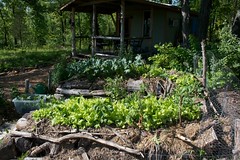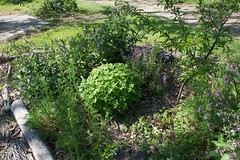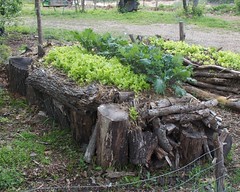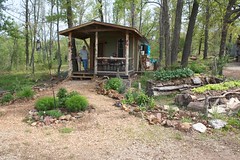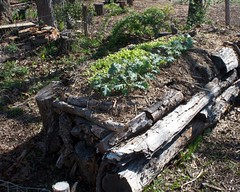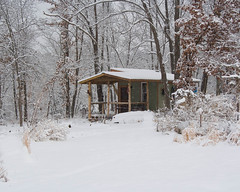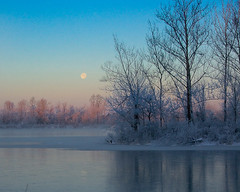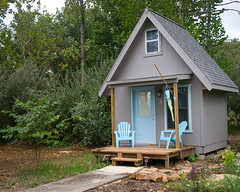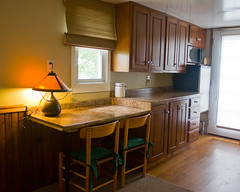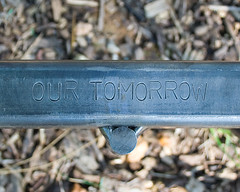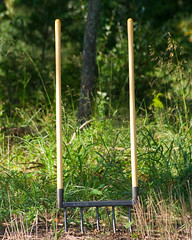Living Simply
More Chickens!
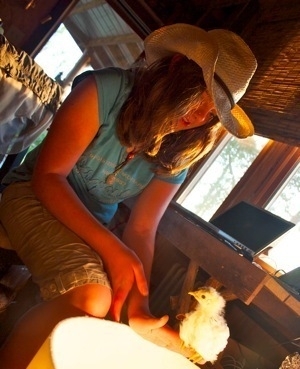
For some reason I never blogged it but back in April I'd gotten 5 new chicks to add to my flock of aging hens. I've only been getting 3-4 eggs a day so thought it was time to add in some new ones. In the past three months I've also lost some from the old flock, Boots the rooster was killed by some critter or maybe Chip (the original rooster) back in March. Then in July, the friendliest hen of the bunch, Waffle, died suddenly. In mid-August another hen died. All the others have been fairly healthy as far as I can tell. I sure hate to see them die.
Today, I decided to go ahead and let the new chicks mingle in with the older flock and so far it's been smooth sailing. I expect a bit of conflict but at 5 months the new girls are every bit as big as the older hens and should be able to take care of themselves. They'll figure out their new pecking order before too long.
Oh, they are Columbian Wyandotte, a very pretty breed, mostly white feathers but with a bit of black around the neck and tail that date back to 1893. Here's a shot from May with my niece Emma holding one in my cabin. I'd raised the Guineas back in the summer of 2009 but this is my first batch of chickens to raise. All the others had been raised by Kerry, Greg and the kids.
Based on my experience thus far it looks like I'll be adding 3-5 new hens each year to replace hens that have stopped laying and/or hens that have died. I think though that I'm pretty happy with this sized flock, which is 15 chickens and 2 guineas. Seems about perfect.
Being a one man shop

This was actually written for the blog on my freelance Mac consulting/web design gig, MacProductive but I thought I'd cross post it here as I'd guess some of the folks that read a site about homesteading might also be interested in making a living doing freelance type work as they seem to mesh together pretty well. I suppose it's meant to just provide a bit of a taste of what the workflow is like for anyone who's not taken the leap but is thinking of it. I may do a few more similar posts, filling in a few details on the things a freelancer has to think about and do.
MacProductive is not a multi-person business. I do it all. Track invoices, meet clients, code css, set-up tables in FileMaker, set appointments, design graphics in Photoshop, write some content, track project status, remind clients when they've not gotten me something I need, slop the hogs and more. Just kidding about the hogs but I do have a small flock of chickens! Going it alone requires organization and a willingness to develop a large skill set. No doubt it is a challenge but it also keeps things interesting.
Oh, and I should offer a bit of context, in this small town setting most of my work is with small business owners, many of which are not all that tech savy. More than a few of them do little more than check email and browse the web. Several of them only have Facebook accounts because a family member insisted and set it up. They are usually middle aged or older and so busy with their businesses that they've not taken the time to really learn what computers and web technologies have to offer.
Here's an example workflow for one of my recent web projects. First, of course, meeting the client. In this particular case I heard from a friend that they were interested in having me do a site so I stopped into their shop when I was in town. Just as often contact is via email or a phone call. Luckily I dropped in at a time when they could actually spend some time meeting so I didn't have to reschedule a return trip for the initial consult.
We spent time discussing the content and design of the site they wanted as well as the domain name. I set a time to return for some photos. We discussed fees and payment and I was on my way. A two days later I emailed them an initial design with some basic content written up and in place. A day later I returned for a follow-up meeting/progress report and to take pictures. We refined the text, filled a few gaps, settled on a domain name and I was on my way.
By the following day I'd set-up the domain name and hosting (which I will manage for them, remind them of payments due... another responsibility for me), refined the text and processed images. At this point I fine tuned the design of the site, photoshopped a few images and then uploaded the site. Over the weekend I made a few more refinements and submitted to Google. The following week stopped in again. At that point the site is, essentially, finished. Time to drop off an invoice. Over the next month or so I'll monitor Google and if the business owner can coordinate with his daughter who manages his personal facebook account, we'll get a business page set-up and linked to. Total time on project: about 7 hours and another hour at the shop talking, over the course of about a week.
Apps used to get it all done: Coda, Transmit, iPhoto, TextEdit and Photoshop to put the site together. iCal for setting meetings/reminders and FileMaker Pro for invoicing.
Petunia and her baby
Petunia was given to me in May 2009 to raise after she was separated from her mother. She's now 2 years old and has her own baby born around May 27th, 2011. Petunia is semi-wild, meaning that she still visits me, allows me to touch her, eats corn from my hand, and, if given the opportunity, will "clean" my arms and hands. She treats me as her mother and at certain times of the year will visit my cabin daily. Other times, usually fall and winter, I might not see her for a week or two at a time.
I don't know yet if the baby is a buck or doe though I'm hoping it is a doe as that would mean Petunia would have a close companion all year. As it is now she hangs with the local deer but I don't think she is a part of their group, probably do to her relationship to me. If the baby is a buck he'll tend to keep more to himself once he has grown up as the bucks keep a bit of distance from the does. Time will tell. In any case the fawn seems healthy and wasn't too afraid of me probably do to Petunia's reaction to me which was not one indicating danger.
My guess is that I'll be seeing them almost daily now that the fawn is past the first week. Petunia visits everyday and the fawn will visit with her. It was amazing to hear the adorable sounds of a nursing baby deer which I'd heard with Petunia when I was bottle feeding her. I forgot just how sweet that sound is. Yes, it is the simple sound of a baby fawn nursing that makes my whole day.
P.S. Where the hell has the month of June gone? This is the third year in a row that we've had a strange spring to be followed by a June that is much more like August. 94-96 degrees??? The forcast for the next 6 days? Above 90 every day. Ugh. While I realize one cannot just look at a day or a month and say, "Ha! Climate change is real and it is upon us!", we've had one record hot year after another. Record numbers of wild fires, record drought, record tornadoes, record hurricanes. Yeah, welcome to human caused climate change.
Heaven on Earth
As an agnostic I don't believe in heaven or hell or any kind of after life. What I do believe in is the beauty and wonder of a simple life lived in the woods surrounded by wild critters. I spent the late afternoon and evening surrounded by such critters. 2 pair of Canada Geese and their 12 young geese as well as the pair that have been hanging around my cabin this spring, Henry and June I call them. After I filmed this and did a few chores I sat on the deck with a blackberry beer and watched them while the cat made himself at home in my lap and demanded attention. Talula sat in the chair next to me. In the background was a mix of John Denver, James Taylor, Bob Marley, Cat Stevens and a few others which blended into the changing soundtrack of birds, frogs and cicadas. Eventually Petunia showed up (without her baby who is nearby) and I fed her some corn. Of course, upon seeing the handout all 18 geese came over and were eating just eight feet from Petunia and I.
Really, if this is not heaven on earth I don't know what would be. I don't need an afterlife. I'm content with this one. I've lived a good life, simple and pretty poor in terms of money in the context of the U.S., but I want nothing more. To be surrounded by such beauty, to be able to cook good food I helped grow in my cast iron skillet, this is living the good life. This is my heaven, right here and right now.
Small is Beautiful!
I decided last year that I'd be shrinking the garden down to the area around my cabin and I can say that, as of right now, that was a great decision! I've got more kale, lettuce and spinach than I was ever able to grow in the big garden thanks to these fantastic hugelculture beds! The work involved in getting them set-up and planted was substantially less even with hauling all the wood and the productivity of these beds is off the charts. I'm probably getting twice as much in a space a quarter the size. There's zero loss to rabbits thanks to the raised beds and the fact that they are so close to the cabin which means I can keep a better eye on them. I harvested a bunch of lettuce today and planted tomatoes, eggplant and peppers in those spots. Salad everyday? Check! Kale cooked in butter with eggs and potatoes four times a week? Check!
The food forests around the cabin are also doing really well. The plum-based guild out front is becoming a really nice example of what can be achieved with the guild model. A plum surrounded by comfrey, sage, thyme, lemon balm, yarrow, currant and gooseberry. I had a couple open spots so I put in a couple sweet potatoes and an eggplant today. The pawpaw guilds behind my cabin had some open spots so I planted sweet potatoes and will be putting a couple eggplant, peppers and tomatoes out there too.
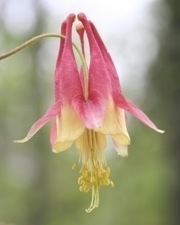 Those guilds already had rhubarb, strawberry, purple coneflower, yarrow, oregano, and self-heal. There are also volunteer pumpkins, potatoes back there and in the swale bed of comfrey and rhubarb I put in onions, tomatoes, and eggplant. I've got as much food planted as last year, all within 60 feet of my garden!
Those guilds already had rhubarb, strawberry, purple coneflower, yarrow, oregano, and self-heal. There are also volunteer pumpkins, potatoes back there and in the swale bed of comfrey and rhubarb I put in onions, tomatoes, and eggplant. I've got as much food planted as last year, all within 60 feet of my garden!
Last, but not least, the native wildflowers have all bloomed and look great: columbine, bee balm, jacob's ladder, wild geranium, purple coneflower with a few others to bloom soon.
First Friday in the new Gallery!

It's been just over a month since we got the keys to the space at 120 West Main and in that time a great team of 12 or so volunteers have put in well over 160 hours transforming it into the new Gallery. We've painted, cleaned, removed carpet and more. We're taking care of some last minute details tonight and then will be hanging art in the next day or so. Come join us for our first art opening in the new Gallery! First Friday Fredericktown is an art opening, potluck, poetry reading and live music the first Friday of each month. This month we'll be showcasing art from local artists Jami Knight, Abi Borrego, Kathryn Buff, Julie Miller and Corey Warner as well as St. Louis artist Aime Oberheim.
It's exciting to have a real space in Fredericktown to display art and host music, poetry and community potlucks. From June through October Fredericktown Revitalization will also be hosting movies and live music in the park on North Main. The Farmers Market will also be there. Our plan is to build the event into a community block party during the warmer summer months with opportunities for any organization or business to sponsor events/games. Chalk art, horse shoes, karaoke and quite a few things have been discussed.
Plenty of rain around here!
In about 10 days we've had over 20 inches of rain fall, 2 inches a day average! It's wet around here as you can guess. The geese are happy campers but the rest of us are ready for some dry time! Looks like most of the next 6 days is set to be sunny but two days have a chance of rain. Ugh. Both of our lake spillways have been running all out for the past 10 days, our bridge and lower road are washed out pretty bad. The other night I realized 2 of our kayaks were left to close to the water and when it came up they went out. I realized this when I woke up at 3:15 in the morning. So I ended up in the last kayak at 3:30 going across the lake with a flashlight in my mouth trying to find them. You don't want a pair of kayaks clogging up your spillway or the culverts under a bridge that is already washing out! Didn't find them but at least verified that they were not in the spillway. Found them the next morning at first light, one washed up on shore and the other in some brush by the dam. Close call. So, kayaking at 3:30 in the morning, 45 degrees with a bit of drizzel? Not recommended! And that was after spending 2 sessions in the lake Saturday and Sunday inspecting for leaks. Our dam has held up very well for the past 20 years and has weathered this recent storm like a real champ! We do have to do a bit of routine maintenance to take care of though. Dams need to be kept clear of trees but covered with grass or some sort of ground cover to protect the clay.
The hugelculture beds are coming along fantastically! Lots of kale, lettuce, spinach and chard in full swing with eggplant, peppers and tomatoes ready to go in once we get past this last cold snap. They handled all the rain really well and my plants are not at all water logged thanks to the elevation. Not only that but those buried logs must be full of water which will help keep the soil moist for many weeks to come. The food forests are all coming along, most notably the one just out my front door is really filling in perfectly with plum, currant, comfrey, lemon balm, yarrow and sage. All the blueberries have come up looking great too.
Our last construction project is nearly finished. The shower house is almost done with only the last bit of plumbing to do. The walls, shower, sink are all in and it's painted. We still have to paint the outside and then finish the upstairs loft where Jake/other guests can sleep. The red cabin is finally totally finished on the inside with a little kitchen sink and cabinets. There's a bit more to do in terms of an outside roof to keep the door dry and an extension on the back side covered area so that the full length of the backside is covered. After that we should be done for a while with construction stuff! Will be nice to spend more time relaxing rather than filling the weekends with constant work. There's still maintenance to do of course but it will be nice to not have air compressors, nail guns and saws constantly running in the background.
Oh, and an animal update. I've had the pleasant tweet tweet of 5 chicks in my cabin for the past 3 weeks! They are growing up fast and so cute with their first feathers in. Petunia is definitely pregnant and will be having her first fawn in the next 30 or so days. She's been around most days for a bit of corn. The two canada geese have also been hanging out by the font porch every day as well, a nice addition! In fact I'm looking at them both right now as they lounge around in my front yard. I love their personalities, mannerisms, and constant vocalizations.
Greening up fast!
It's been a couple weeks since I posted about planting the hugelculture beds. They're a carpet of green: lettuce, spinach, chard, radishes, onions and kale. Another week or two and I should be harvesting lots of salads! It will be interesting to see how well they produce, especially once I start adding in the bigger plants like tomatoes, peppers, eggplants and squash. The tomatoes, peppers and eggplants are doing great in the greenhouse with another batch started a week ago. The rhubarb is about ready for a first harvest and the comfrey already has flowers!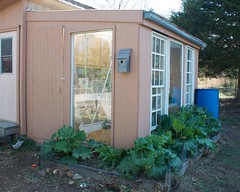 The food forests are also coming alive with fruit trees taking off as well as all of the perennial herbs: oregano, lemon balm, sage, thyme, yarrow, purple coneflowers, feverfew, and tansy. The blueberries, currants, serviceberries, gooseberries and pawpaws are also awake and growing rapidly. Last but not least, the hardy kiwi vines have really taken off and look great.
The food forests are also coming alive with fruit trees taking off as well as all of the perennial herbs: oregano, lemon balm, sage, thyme, yarrow, purple coneflowers, feverfew, and tansy. The blueberries, currants, serviceberries, gooseberries and pawpaws are also awake and growing rapidly. Last but not least, the hardy kiwi vines have really taken off and look great.
All of my native perennial wildflowers are also coming up and doing well a year after transplanting. Orange coneflowers, bloodroot, jacob's ladder, geranium, primrose, columbine, bee balm, cardinal flower and blue lobelia.
Last, I'm not a big fan of grass but late last summer we trenched in our water line from the well to the two cabins and the grass never reestablished so I've had LOTS of mud around here. We seeded it with a mix of grass, red and white clover, all of which is starting to rally take off. I'll be glad to be rid of all the mud!
Missouri's Madison County

I mentioned recently the work I've been doing with our local main street group, Fredericktown Revitalization and the local Chamber. The latest work has been focused on organizing a First Friday event and a space for art and poetry in Madison County Missouri. We've made a good bit of progress with a variety of improvements to our historical buildings as well as several successful community events.
This is a fairly depressed area, economically and morally. It's hard to get folks out of the rut they are in, there's a lot of negativity. There's not much here in the way of art or spaces for teens or young adults. It will be interesting to see what kind of support and interest we get from the community, especially the younger part of it.
Garden Rising
We're in the middle of what will, hopefully, be our last cold spell of the season. March has been pretty nice in terms of temperature and precipitation. Today it's cold and raining but over the past week I've gotten all my cold crops in. Peas, lettuce, chard, spinach, kale, radish, onions and potatoes. Larry Cooper's broadfork was amazing for loosening up the soil! So easy to use. Thanks again Larry! I'll be encouraging my local garden friends to take a look at these for their own gardening.
The tomatoes, peppers, and eggplant were all started about 2 weeks earlier than last year and have now been transplanted out into little pots and are sitting on my cabin table with a light on them. The fruit trees are all budding out and have flowers. The comfrey and rhubarb are popping up everywhere and the bed by the greenhouse most of all. Those plants are already full of leaves and nearly a foot tall. If they don't get killed off by the cold I could probably get a rhubarb harvest in another week or two! Is that normal?
In other news I've been seeing Petunia around several times a week and I've got two Canada geese that have been hanging out. Not nearly as friendly as Loretta but they are less afraid every day and have been coming up for snacks and visiting just 10 feet from the front porch a few hours a day. I love geese. Their mannerisms are adorable and they are such beautiful birds.
I suppose that's it on homestead news. I'll post a few garden pics soon.
Solar Air Heater!
The new solar air heater leaning up against the well/shower house where it will likely be installed as it is a near perfect south facing wall. Thermometer reading after just a minute behind the air outlet? 100 degrees and that's with outside air of 48. NICE! My guess is that this would easily heat our little shower house to a comfortable 70+ degrees on sunny days during the winter. A big thanks to Rick for building it!
Update 1: Went back out to get another temperature reading, 110 degrees! From what I've read online they can be expected to output air between 100-130 degrees or more on sunny days. Even on cloudy days they will put out air that will warm a space though obviously not as effectively.
Update 2: As of this update (1pm) it is 50 degrees outside and the current reading is 120+ (my thermometer tops out at 120) that's a 70 + degree gain.
So, cost on these, is 4x8 plywood, 2x4, paint, caulk, silicone, tempered glass assuming it is all bought new probably $100-150. My guesstimate is that in one winter the savings on electricity would be $300-500 depending on the use scenario. Cost on keeping our well/shower house heated to 50 degrees this winter has probably been $60-80, maybe more. To keep it heated to 75 for comfortable shower house temps would have been MUCH higher, easily $200+ as it would require an actual heater, not just the two heat lamps I currently use. Using the solar air heater, I think we'll be able to keep this structure heated to at least 75 on sunny days, for free next winter.
Winter into Spring
I think we've seen the coldest part of the winter and are on the way to warming and I'm happy for it. Don't get me wrong, I really love the winter. I love the snow and the frozen ground. The still of the frozen lake and the sound of the winter birds, there is a certain peace to a zero degree morning. And there is the comfort of a wood stove and coffee or soup that contrasts with the frozen outdoors. But right now, today, it is 52 degrees and sunny. Our last snow which fell this past week is now gone. I love the muddy mess outside. Love it.
The weather folks on TV say that we're going to have a week straight 50-65 degree days. I know that as soon as the lake has turned to water I will hear my beloved frogs, the Spring Peepers, as they welcome the spring. For me, that is the first day of spring, the day that I first hear the peepers. I expect that I'll hear them tomorrow and I cannot wait. I've got seeds from Baker Creek Seeds waiting to be planted. I'm going to do a couple tomato and pepper plants early this year, a month earlier than my normal start. Just an experiment to see how early I can go.
I'll soon be missing the cold and the fire but I'll welcome the spring green.
Petunia is alive and well
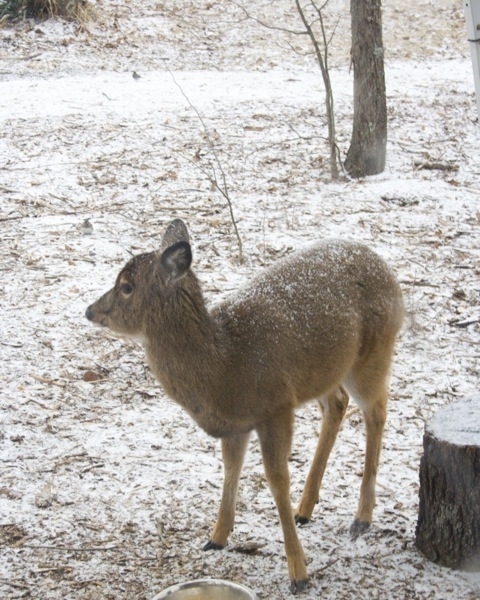
Good news regarding Petunia!! I'd mentioned in a recent post that I'd not seen her and that I was worried she might have been shot during hunting season. I took a walk into the woods the other day and spotted the little group she hangs with. I was talking loudly to myself so that if she was around she'd hear me. It was funny, I was watching the group as they leaped off into the woods, about 200 feet away and I just kept walking slowly down the trail thinking that if she was in the group she'd come back to me. Then I glanced to my left and she was right there, just 20 feet away and coming to me. Ah, so sweet. Relief. We hung out for about 15 minutes and then I left her. She followed me for a few minutes but then turned and went back in the direction of her friends. She seems healthy. We had a fantastic acorn crop so she's got plenty to eat. In fact I'd taken some apple out there and offered it to her, she wasn't interested. Didn't even take a nibble. I wonder if she mated this year and if she'll be having her first fawns this year?
The picture above was taken last winter. Amazing just how fluffy they look with their winter coats. The hair is hollow to hold air for insulation. I'm not too sure of the mechanics of it but it seems that when it gets really cold their skin contracts and the hair stands up creating the fluffy appearance and probably increasing the insulation effect of the hollow hair.
The Quiet of Winter
I love every season. Winter no less than the others. The quiet only makes the song of birds more amazing. The lake has frozen with the below normal temperatures of December and the ice makes these haunting sounds as it cracks as a part of the freezing process. I don't really know the mechanics of it but the sound is really amazing and even though I expect it the cracks and strange echos often take me by surprise.
It's been two months since my last post!! I've spent most of that time doing the usual fall/winter chores. Winterizing the waterline behind my cabin was the top priority and beyond that it is the usual of chopping wood, keeping the wood stove going and keeping an eye on the chickens. We've already dipped into the single digits and had about a whole week below freezing. Last December was pretty cold too but I think not quite as prolonged. I think I prefer the extreme cold of winter to the extreme heat of summer. At least in the winter I can put on as many layers as needed and I'm plenty toasty. In the summer one can only be so naked.
Another thing to love about winter is soup and I make it constantly once the cold sets in. Mostly variations of vegetable soup and pumpkin coconut curry. Not only is it hot and tasty but you can't make a cheaper meal.
We never got the door on the greenhouse and while the improvised door put on when we built it does a fine job of mostly keeping out the wind and cold, it does nothing to keep out mice. It fits pretty well but does have some entry points for mice and so my winter greens, mostly kale, have largely gone towards keeping those furry little shits well nourished. Really need to figure out a way to deal with them. Yes, yes I know traps would work but honestly, I think there are quite a few in and around the chicken coop, I'm not sure traps would really do the job. Maybe that is the only way. It goes without saying that I don't use poison... (wait I just said so I guess it doesn't go without saying). Funny, I never really thought about mice as an issue with a greenhouse until I had one.
The girls have finally started laying more eggs. For a couple months I was getting no eggs, or very few. While I think it is fairly rare in the U.S. I'm convinced they had a virus called egg drop syndrome as they had numerous symptoms that matched such as weak shells, bumpy, rough shells, and sometimes no shell at all, just a membrane. Some have told me maybe it was the combination of the extreme heat of summer and molting but I don't think that totally explains at and the shell irregularities point to something else. At this point not only are they laying again but their shells are much thicker and pretty much back to their normal color and texture.
Potentially sad news regarding Petunia the deer... I've not seen her in almost a month. Now, she might be fine but she's never been absent this long before. I'm hoping she was not shot during deer season and it may be that she really is fine, I don't know. She might well have mated with a buck this year and perhaps that might change her behavior? I know that there is a little cluster of deer that she seemed to be hanging out with so maybe she's just with them. Still, I would not think that she would just completely stop visiting me after being so consistent for the past 16 months.
Okie Dokely, I think that's it for the moment. Hope you all are doing well.
Getting stuff done: Hugelkultur beds and greenhouse bed
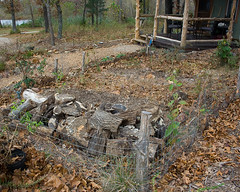 With questions about my residency I'd put a few projects on hold but now that it's all cleared up I've gotten back to work.
With questions about my residency I'd put a few projects on hold but now that it's all cleared up I've gotten back to work.
I doubt it is possible to mouse-proof a greenhouse but I did my best. Last year they ate up my greens, this year hopefully it won't be so easy for them. I put some semi-composted chicken bedding into the soil and got some kale, lettuce, spinach and chard planted. We'll see what happens. I've also stapled up the remaining bubble wrap on the inside ceiling for an added layer of insulation. Last, I've got the north side wall that is shared with the chicken coop stacked up with an internal straw bale wall. I'll also put bales on the east side. I noticed last year that while the water filled black barrels never froze up they also never gained any noticeable heat. Yeah, they were thermal mass but not warm. What I did notice though was that the straw bales that were in there warmed up really well. I figure it can't hurt and will likely help a great deal. I'll share data as the winter progresses. I'll keep one barrel inside filled for watering the plants.
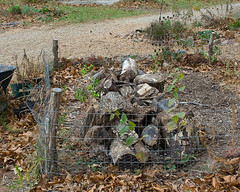 Next on the list, start the Hugelkultur beds in the little keyhole beds outside my cabin. For those that don't know, Hugelkultur is a form of raised garden bed using wood. This is especially important for me because the soil in this garden is contaminated with lead. Years ago this area was heavily mined and in fact the whole area is called the lead belt. The history of these towns is all based on the mining. Years later folk that probably shoud have known better but apparently didn't started using the tailings piles for roads, driveways and anywhere gravel, rock, or sand might be used. They used it around the lake on the roads and back in the 1970s and 80s they used it all around this place for the camp sites. Not smart. I could have them come in and take out the soil but frankly it is a huge mess and I don't necessarily trust the "soil" they bring in to replace the bad stuff. There's certainly nothing fertile about it as it is the brightest red clay you'll ever see. So, my intent is to build keep these beds raised high above the ground level, contaminated soil. I'll just rebuild them every couple of years until I've gotten several feet up.
Next on the list, start the Hugelkultur beds in the little keyhole beds outside my cabin. For those that don't know, Hugelkultur is a form of raised garden bed using wood. This is especially important for me because the soil in this garden is contaminated with lead. Years ago this area was heavily mined and in fact the whole area is called the lead belt. The history of these towns is all based on the mining. Years later folk that probably shoud have known better but apparently didn't started using the tailings piles for roads, driveways and anywhere gravel, rock, or sand might be used. They used it around the lake on the roads and back in the 1970s and 80s they used it all around this place for the camp sites. Not smart. I could have them come in and take out the soil but frankly it is a huge mess and I don't necessarily trust the "soil" they bring in to replace the bad stuff. There's certainly nothing fertile about it as it is the brightest red clay you'll ever see. So, my intent is to build keep these beds raised high above the ground level, contaminated soil. I'll just rebuild them every couple of years until I've gotten several feet up.
Hugelkulter is not hard to explain but I found this excellent post that does the job well:
Hugelkultur: Using Woody Waste in Composting:
Hugelkultur is an ancient form of sheet composting developed in Eastern Europe. It uses woody wastes such as fallen logs and pruned branches in order to build soil fertility and improve drainage and moisture retention.
If you walk through a natural woodland, you will see many fallen logs and branches on the ground. The older these logs are, the more life they sustain. A log that has rested on the forest floor for five or ten years will be covered in moss, mushrooms, wildflowers and even young trees. Poke at it a little and you will notice that the decaying wood is damp in all but the most vicious of droughts.
Hugelkultur is designed to take advantage of the natural fertility and moisture-conserving qualities of rotting wood, while speeding the process of decomposition up. The heat produced by decomposition also helps protect cold-sensitive plants.
In the photos above you can see I've got the semi-rotted wood hauled in and ready to be covered with straw, chicken manure, the last several scoops of wood chips we have. That wood is stacked up about 20 inches. I've got some good soil from our old wood pile (where this wood came from) and will just wheel barrel it down and add for the top layer. It's great stuff full of the rotted bark of lots of logs and is not contaminated. The final beds should be 24 inches above ground level. I'll post photos of the beds when they are completed. These will absorb water all winter and in early spring will be like water filled sponges. The decaying wood will rob the soil of nitrogen so I'll have to fertilize these beds heavily with chicken manure but I think it will be good and is certainly better than digging and growing in contaminated soil.
Land Update
It's been a crazy roller coaster this past two weeks. Since my last update we went back and forth several times first thinking we had it worked out to then not and back and forth again. I didn't want to post until things seemed to settle into something solid enough to report. While there is no final resolution I feel pretty good at where we are at with things. Basically we are back to square one with much better communication and understanding. The land has been taken off the market and if it goes back on it will be up to each of the three siblings to keep or sell their own third and when it happens it will be offered to siblings/family first. If this pans out as it looks my dads share is safely within the family for many years so our work is now, in theory, protected. I don't want to say much at the moment but yeah, we're good. I have a feeling I'll be here for a long time to come. The side benefit is that after the past two weeks of thinking I was going to lose the place I now have a new appreciation for what I had come to take for granted.
Thanks to you all for following along and for your thoughtful, kind comments in the last post. Your words offered a great deal of comfort and encouragement and I greatly appreciate it.
A Little Village
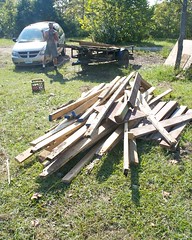 Yet another building is almost finished. Our well house, shower, guest cabin in process. We began by "harvesting" a couple of trailer loads of 2x4, 2x6, and plywood lumber from an old shack behind the dam. We've now salvaged enough from that old structure to build three buildings and have exhausted all the material that was useable. The idea was to rebuild our well house which was very small and not at all easy to do maintenance work in. It needed some work anyway. Rather than just repair it we decided to build something a bit bigger in which we could also put a shower and have some room for storing paint and other items that need to stay warm in the winter. I don't have much room in my cabin to store that stuff and last year kept in a sectioned off part of the chicken coop which is not an ideal place for it.
Yet another building is almost finished. Our well house, shower, guest cabin in process. We began by "harvesting" a couple of trailer loads of 2x4, 2x6, and plywood lumber from an old shack behind the dam. We've now salvaged enough from that old structure to build three buildings and have exhausted all the material that was useable. The idea was to rebuild our well house which was very small and not at all easy to do maintenance work in. It needed some work anyway. Rather than just repair it we decided to build something a bit bigger in which we could also put a shower and have some room for storing paint and other items that need to stay warm in the winter. I don't have much room in my cabin to store that stuff and last year kept in a sectioned off part of the chicken coop which is not an ideal place for it. 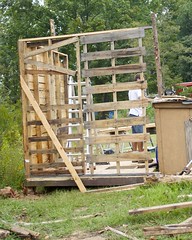 Once we started building it we got to thinking that we had enough salvaged lumber to add on a short second story for extra sleeping space. The only added cost would be the plywood for the loft floor and the exterior siding. We had the old kids' playhouse which was originally built from shipping crates and pallets so that wood has now been repurposed twice! We cut them down to size and put them up.
Once we started building it we got to thinking that we had enough salvaged lumber to add on a short second story for extra sleeping space. The only added cost would be the plywood for the loft floor and the exterior siding. We had the old kids' playhouse which was originally built from shipping crates and pallets so that wood has now been repurposed twice! We cut them down to size and put them up. 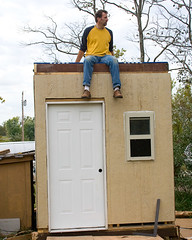 The top floor is now mostly enclosed with roof on, will sleep 3-4 folks though at 5.5 feet it is not a standard height and requires a bit of stooping. With my nephew at 14 he may be wanting to bring down friends then there is my brother and his hunting buddies and I get the occasional visitor so having some extra sleeping space would be good.
The top floor is now mostly enclosed with roof on, will sleep 3-4 folks though at 5.5 feet it is not a standard height and requires a bit of stooping. With my nephew at 14 he may be wanting to bring down friends then there is my brother and his hunting buddies and I get the occasional visitor so having some extra sleeping space would be good. 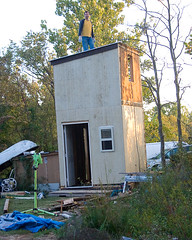 We purchased the siding and metal roof, all other lumber was salvaged as was the insulation. And yes, my brother in law Greg did come down off the roof eventually. I love the crazy shape of this thing... kinda feels like a tree house or a watch tower. We'll probably be putting a deck/walkway on the west and south facing sides. The view from this top floor is really nice. Not only the lake but the garden and other structures we've put up. It is really starting to feel like a little village.
We purchased the siding and metal roof, all other lumber was salvaged as was the insulation. And yes, my brother in law Greg did come down off the roof eventually. I love the crazy shape of this thing... kinda feels like a tree house or a watch tower. We'll probably be putting a deck/walkway on the west and south facing sides. The view from this top floor is really nice. Not only the lake but the garden and other structures we've put up. It is really starting to feel like a little village.
Early Fall
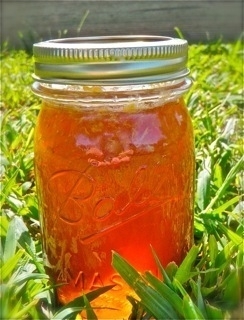
I've really been enjoying the sustained cool weather of late summer. I'm trying to get caught up on my winter firewood. I should get it chopped in spring and early summer so it dry out all summer but coming off of winter I'm usually chopping wood daily for the next day and getting the spring garden going so I once the weather warms I've had my fill of chopping and put it off. Right now it's not a big problem as much of the wood I have has been down for a few years and seems to dry pretty darn fast once I've chopped it up and gotten it covered. In the next couple days I should be able to get enough wood done to last me through December. If the weather is good over the next week or two I should be able to get enough done to get me through January or February. I actually don't mind chopping in the winter as it is the only exercise I get and it warms me up on a cold day... as the saying goes, wood warms you up twice.
Aside from the wood I'm slowly working through the jungle of weeds that the summer garden became when I gave up on it. Putting them as a big layer of mulch out around the blueberries so they'll compost into the soil. There is no doubt the soil around here has been greatly improved over the past two years. So much looser and full of earthworms and nutrients... yes, I'm very happy with the soil! Really, that's what I love the most is the soil. I enjoy gardening but I love enriching the soil and digging my hands into it. I'll probably cover the garden this fall with lots of cardboard and straw which I did not do last fall or spring, hence all the weeds. As I said recently I don't plan to plant the garden next year. I'll just let it sit and rest. The real problem is it is way too big for one person.
Next big outside project is to get any rotten wood hauled up into the small garden to start the Huegelkultur process. Next year I'll focus on a smaller area and see what I can produce. I think I'll be alot happier. Other than that we've got to get the new well house built and I've got to get my new waterline winterized. Oh, yeah, I've got water straight from the well now! I don't think I mentioned that before. So nice to turn on the faucet and have cold, drinkable water! That luxury will make living here in the winter so much easier!
Bees and chickens, chickens and bees. I don't know if I want to keep the bees. I hate to give up on a project but I just don't know that I want to keep them and am leaning towards selling them. I spent a good bit of time this past fall and spring keeping them well fed with sugar water. I did everything (almost) by the book and had such an amazing healthy hive back in March only to have it split twice and end up with a fairly small hive that hasn't produced much in the way of honey. We got one good, full frame which gave us two pints of beautiful, sweet honey. The remaining frames are only partially pulled out and capped. Not counting the equipment investment, I probably spent $15 in sugar... those are two very expensive pints of honey! You could argue that the cost of the boxes, if spread out over 10 years is a good investment but the sugar water is something that has to be fed ongoing. On the one hand I do love certain aspects of bee keeping but I'm not sure it is enough to keep them. It's a project that only gets bigger and more time consuming as the hives grow and split and grow and split.
The chickens have been another frustration this summer. The egg harvest went way, way down and really I was/am confused about what the exact cause was. Part of the problem was my own doing I think. Somehow I missed the lesson about the importance of calcium in their diet. I knew they needed it and had been feeding them their ground up egg shells. I did not realize just how important it was though and didn't know that I should probably also be feeding them oyster shells. I did notice their shells were not real strong and then a funny thing started happening. Egg production started to decline back in June and I also started noticing eggs with just a membrane or in some cases no shell at all. They would just sort of lay a blob of egg. This was happening at the same time that black snakes moved in and started stealing eggs. I think I captured at least 8 in July and August. But because of the snakes I didn't realize that they were starting to lay fewer eggs. Add to this mix the fact that I caught the hens themselves eating a few eggs and I've got at least three or four variables/explanations. As of the past two or three weeks I've been lucky to get 2-3 eggs a day from 11 hens.
While I do adore my girls I don't keep them as pets and I want to be able to sell enough eggs that they at least pay for their feed. I've been feeding them oyster shells for a month and am hoping that helps with the soft shell and reduced egg laying. In a way it may be a good thing that they are taking a break from laying because I'm seeing that they are getting their feathers back. Now that I've got their diet fully rounded with the calcium source I'm hoping that perhaps we'll go into the fall with fully feathered, rested hens that have a more balanced diet. I feel terrible that my ignorance contributed to them not being as healthy as they should be.
All in all it was a difficult summer but we've made real progress. A covered porch, running water, renovated interior in the red cabin, lots of new perennial garden beds and no major losses. Kerry and Greg and the kids will be able to spend alot more time down here thanks to the red cabin remodel so that is good news. In theory the work done this summer should make for more frequent and more comfortable visits for my folks as well since they stay in the red cabin too. The next big project is a porch for the red cabin which we should be able to knock out in a couple weekends next spring. There's a good bit of perennial landscaping I'd like to do around the cabins next spring but nothing too crazy. Next year should provide lots more time for enjoyment and less time with construction.
The Gulland Forge Broadfork!
The UPS guy showed up a little bit ago to deliver my new, hand-made broadfork gifted to me by Larry Cooper. He makes them by hand and let me tell you, what an awesome tool. The ash handles had a really nice smell thanks to the linseed oil/turpentine finish and I pushed them into the metal fork assembly. It was then that I noticed the engraving "Our Tomorrow" which, honestly, brought a tear to my eye. Just when I thought such a gift could not possibly get any better there is that thoughtful detail. Larry: THANK YOU.
I've not had a chance to use it much yet as I was eager to post this. But I DID use it a bit and wowza, this is one fantastic tool. It just works, like an extension of the body. I stepped on to the center of it and my weight pushed it into the earth and then I just gave it a gentle rock back to loosen the soil. I can't wait to work some beds with this! Everything about it from the handles to the tines just feels so solid. America needs to return to this kind of hand-made quality.
Will post more when I've had a real chance to give the broadfork a real workout!
Gulland and his Broadfork Blog
After yesterday's post I got a comment from Gulland offering to send me a gardening tool that he makes. He didn't mention what it was so I went looking at his blog and found that it is called the broadfork. I've heard of this tool but never used one. From what I read it is used to replace the tiller and is kinda like a very wide pitchfork to loosen/till the soil. I don't generally till as I prefer disturbing the soil as little as possible leaving the soil community intact but I do use a sorta modified double dig method on my beds when I first set them up which lossens the soil 1-2 feet down resulting in a raised bed of loose soil 2-3 feet in depth. It seems this is the perfect tool for that as well as for loosening the soil every couple of years. Not only does it not use oil but I'd guess that it is a much more gentle process in terms of disrupting the layers of the soil. I think it aerates the soil without turning the layers, thus adding oxygen and improving the soil structure without destroying the soil community. That it is human powered is very important given our current climate, peak oil situation. Here's Gulland's blog post reply to a gardener named Tom and I thought I'd post it here as it addresses the issue perfectly:
Tom told me that he never even cranked his rototiller this year; he did it all with the broadfork he got last year. He also said that he would never have to use the rototiller in any of those beds again.
That's heavy stuff to me; I have created a business that provides an implement that allows people to step back from the use of fossil fuels to do the 'heavy lifting' in their gardens. Because of my broadfork, there is one less rototiller running in California this year!
Tom, I have to say that your email and photos have made me know that I am doing the right thing. Thank you for turning the lights on for me.
I am an Alabama native, and lived my first 42 years there. The Gulf of Mexico was in my backyard, and I loved visiting that coast.
The point of this blog was to inform people about the utility of the broadfork and give some insight into the man that makes them. I never wanted to be political, or controversial. I must say, however, that the disaster that has occurred with the deep water drilling platform in the Gulf of Mexico has made me feel that any time I can steer someone away from the use of fossil fuels to good old fashioned hand labor, I have done a good thing. The reason you are reading this is that you believe the same thing that I do.
We need to lessen our need to use petroleum products. The low hanging fruit has all been picked, and the rest of the crude oil that is available is in the inhospitable places where it is probably best to just leave it alone.
When I've had a chance to try it out I'll be sure to post a review. If only I'd had a tool like this over the past decade or two I might have fewer back problems!! A big thanks to Gulland for getting in touch and for his generous offer.
Opps, edit. I did some more reading and wow. Gulland is not only building a great tool but the way he does it is a fantastic example of building the local economy. In these times of rising unemployment and a job market dominated by meaningless jobs at Wal-Mart and McDonalds, Gulland is creating a useful tool from scratch! Read more in this post on his blog.
